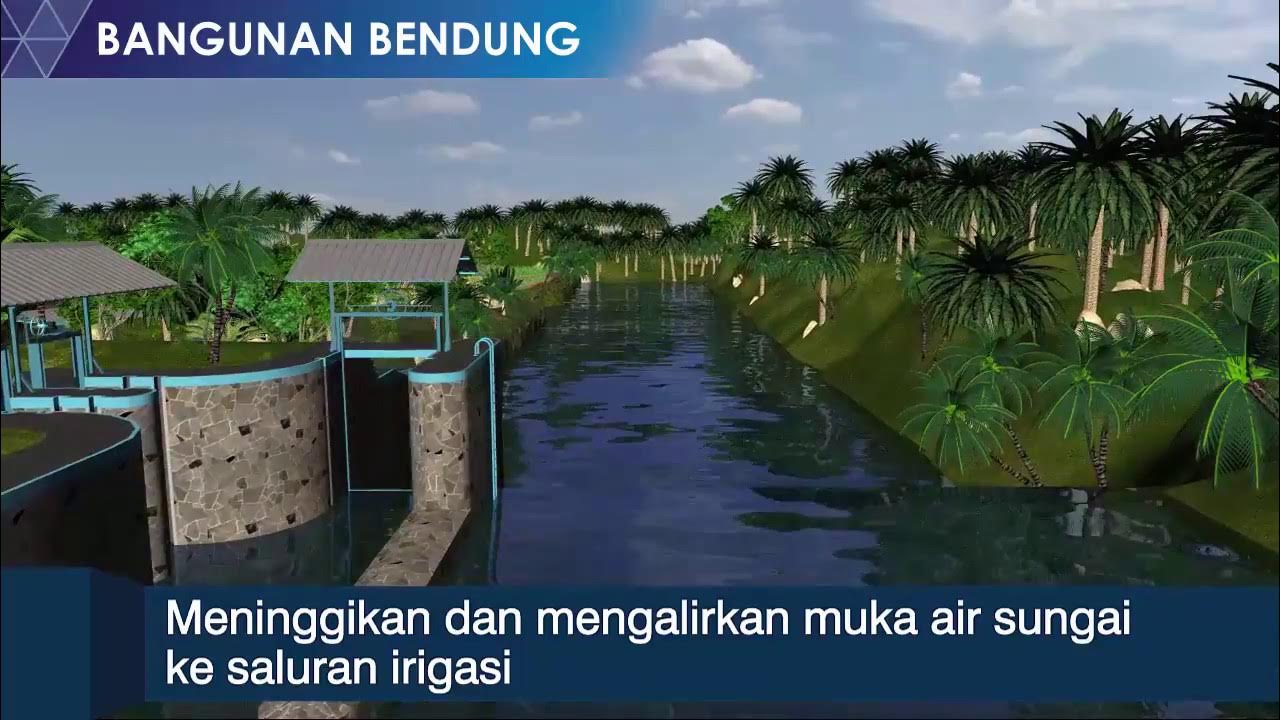Perencanaan Bangunan Bagi - Sadap
Summary
TLDRThis video script provides an in-depth explanation of irrigation structures, focusing on 'bangunan bagi' (water dividing structures) and 'bangunan sadap' (water tapping structures). It details their functions in regulating and distributing water from primary channels to secondary and tertiary systems. The script covers the design considerations, including the dimensions of gates and flow angles, and highlights their importance in efficient water distribution for agricultural areas. It also addresses maintenance issues, the need for community involvement, and the calculation of appropriate hydraulic components to ensure optimal performance in irrigation systems.
Takeaways
- 😀 Diversion structures ('bangunan bagi') are located at branch points in primary channels and divide water into secondary channels or between multiple channels.
- 😀 Take-off structures ('bangunan sadap') divert water from primary or secondary channels to tertiary channels, serving fields for agricultural irrigation.
- 😀 Both diversion and take-off structures regulate water flow using gates that measure and control the distribution of water to ensure fairness.
- 😀 Take-off structures are typically larger than 250 liters per second and serve secondary irrigation, while tertiary take-off structures generally range from 50 to 200 liters per second.
- 😀 A combined structure known as 'bangunan bagi sadap' merges the functions of diversion and take-off structures in one system.
- 😀 Auxiliary components such as measuring structures ('bangunan ukur') are used to assess water flow at various points in the irrigation system.
- 😀 Water flow is regulated through gates and regulators, designed to minimize obstacles and maintain the efficiency of the system.
- 😀 Structural design should account for water levels, gate dimensions, and the elevation of both the primary and tertiary channels to ensure optimal flow.
- 😀 Hydraulic calculations for gate openings, such as using the formula 'I = Miu AB Ali sqrt(2gz)', are important in determining the correct size for water flow.
- 😀 Maintenance of irrigation infrastructure requires active community and operational involvement to handle issues like debris, wear, and potential construction damage.
- 😀 There are two common layouts for the placement of these structures: sideway and aligned with the flow, each with specific benefits and challenges.
Q & A
What is the function of a 'bangunan bagi' (distribution structure) in an irrigation system?
-A 'bangunan bagi' is used to divide the water flow from a primary channel to secondary channels or between multiple channels, ensuring that water is evenly distributed to different areas.
What components are included in a 'bangunan bagi' structure?
-A 'bangunan bagi' typically consists of gates that regulate the water flow and devices that measure and adjust the water being distributed to various channels.
What distinguishes a 'bangunan sadap' (diversion structure) from a 'bangunan bagi'?
-'Bangunan sadap' diverts water from a primary or secondary channel to a tertiary channel. It serves multiple tertiary plots, whereas 'bangunan bagi' is primarily for dividing water between channels.
What is the typical capacity range of a 'bangunan sadap' structure?
-A 'bangunan sadap' typically handles water flows ranging from 50 liters per second to 200 liters per second, depending on the irrigation system's needs.
What are the challenges associated with the construction of 'bangunan sadap' for tertiary channels?
-Building 'bangunan sadap' for tertiary channels can be expensive, especially when the water surface elevation is low. In such cases, simpler structures like sliding gates are preferred for cost efficiency.
How does a 'bangunan pengatur' (regulating structure) function within the irrigation system?
-A 'bangunan pengatur' is used to control the water level within channels where 'bangunan bagi' and 'bangunan sadap' are located, ensuring efficient water flow and preventing energy loss in the system.
What is the significance of the velocity of water at regulating structures?
-The velocity of water at regulating structures should not exceed 1.5 meters per second to minimize energy loss and prevent erosion or damage to the infrastructure.
What are the two possible layouts for a 'bangunan bagi' structure?
-The two possible layouts are the 'sideways' layout, where the diversion structure is placed at an angle to the water flow, and the 'longitudinal' layout, where the structure is aligned parallel to the flow direction.
What is the advantage of the 'longitudinal' layout for water distribution structures?
-The 'longitudinal' layout ensures that water velocity is consistent, making it more accurate for proportional systems, though it requires more space compared to the 'sideways' layout.
What challenges are typically encountered in the field regarding irrigation structures?
-Common challenges include the accumulation of debris and the deterioration of construction materials, which can affect the functionality of the water distribution system. Proper maintenance and community involvement are crucial to prevent these issues.
Outlines

Этот раздел доступен только подписчикам платных тарифов. Пожалуйста, перейдите на платный тариф для доступа.
Перейти на платный тарифMindmap

Этот раздел доступен только подписчикам платных тарифов. Пожалуйста, перейдите на платный тариф для доступа.
Перейти на платный тарифKeywords

Этот раздел доступен только подписчикам платных тарифов. Пожалуйста, перейдите на платный тариф для доступа.
Перейти на платный тарифHighlights

Этот раздел доступен только подписчикам платных тарифов. Пожалуйста, перейдите на платный тариф для доступа.
Перейти на платный тарифTranscripts

Этот раздел доступен только подписчикам платных тарифов. Пожалуйста, перейдите на платный тариф для доступа.
Перейти на платный тариф5.0 / 5 (0 votes)






